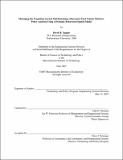| dc.contributor.advisor | John D. Sterman. | en_US |
| dc.contributor.author | Supple, Derek R. (Derek Richard) | en_US |
| dc.contributor.other | Massachusetts Institute of Technology. Technology and Policy Program. | en_US |
| dc.date.accessioned | 2008-02-27T20:36:07Z | |
| dc.date.available | 2008-02-27T20:36:07Z | |
| dc.date.copyright | 2007 | en_US |
| dc.date.issued | 2007 | en_US |
| dc.identifier.uri | http://hdl.handle.net/1721.1/40297 | |
| dc.description | Thesis (S.M.)--Massachusetts Institute of Technology, Engineering Systems Division, Technology and Policy Program, 2007. | en_US |
| dc.description | This electronic version was submitted by the student author. The certified thesis is available in the Institute Archives and Special Collections. | en_US |
| dc.description | Includes bibliographical references (p. 68-75). | en_US |
| dc.description.abstract | Designing public policy or industry strategy to bolster the transition to alternative fuel vehicles (AFVs) is a formidable challenge as demonstrated by historical failed attempts. The transition to new fuels occurs within a dynamically complex system with many distributed actors, long time delays, several important feedback relationships, and multiple tipping points. A broad-boundary, behavioral, dynamic model with explicit spatial structure was previously developed to represent the most important AFV transition barriers. Using California as an illustrative testing region, the model simulates the spatial diffusion of entrant vehicle/fuel technology pairs individually or in competition with other entrants. In this work, the integrated model is carefully parameterized for various specific alternative vehicle technologies. Structural and parametric sensitivity analyses are used to build understanding of system behavior and to identify policy leverage points or the need for further model calibration. | en_US |
| dc.description.abstract | (cont.) The qualitative impacts of policies are tested individually and then in multi-policy combinations to find synergies. Under plausible assumptions and strong policies, AFVs can achieve successful diffusion but this process requires long time periods. Findings indicate some commonly suggested policies may provide little leverage and be very costly. The analysis reveals the importance of designing policy cognizant of the system structure underlying its dynamic behavior. Several examples demonstrate how policy leverage varies with context such as key attributes of the alternative vehicle technology. Broadly, coordinated portfolios of policy instruments should be designed to simultaneously develop consumer familiarity, well distributed fueling infrastructure, and manufacturer knowledge at similar rates and over long enough duration to surpass thresholds in these complementary assets before alternative fuel and vehicle markets become self-sustaining. Further, policy should dynamically adapt to observed conditions to lessen the transition constraints dominant at the time. Policy and strategy makers must recognize from the outset that incentives must be stable over long durations for AFV transitions to succeed. | en_US |
| dc.description.statementofresponsibility | by Derek R. Supple. | en_US |
| dc.format.extent | 97 p. | en_US |
| dc.language.iso | eng | en_US |
| dc.publisher | Massachusetts Institute of Technology | en_US |
| dc.rights | M.I.T. theses are protected by copyright. They may be viewed from this source for any purpose, but reproduction or distribution in any format is prohibited without written permission. See provided URL for inquiries about permission. | en_US |
| dc.rights.uri | http://dspace.mit.edu/handle/1721.1/7582 | |
| dc.subject | Technology and Policy Program. | en_US |
| dc.title | Managing the transition toward self-sustaining alternative fuel vehicle markets : policy analysis using a dynamic behavioral spatial model | en_US |
| dc.type | Thesis | en_US |
| dc.description.degree | S.M. | en_US |
| dc.contributor.department | Massachusetts Institute of Technology. Engineering Systems Division | |
| dc.contributor.department | Technology and Policy Program | |
| dc.identifier.oclc | 191061044 | en_US |
